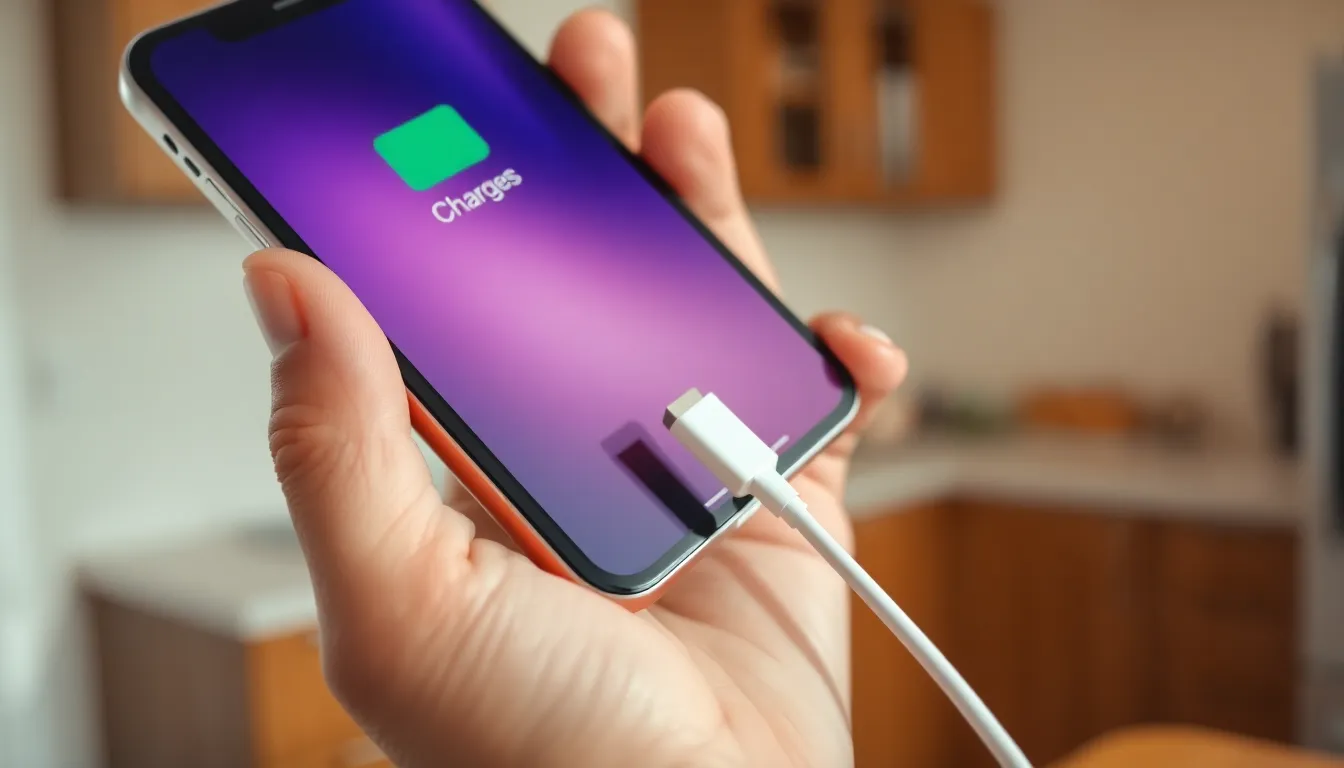Picture this: you plug in your iPhone, and it’s as silent as a ninja in the night. You wonder if it’s charging or just playing hard to get. It’s a common dilemma that leaves many scratching their heads. Knowing if your device is charging when it’s off can save you from the dreaded “low battery” panic.
Table of Contents
ToggleUnderstanding iPhone Charging Behavior
Many users seek clarity on whether an iPhone charges while powered off. This understanding allows for accurate battery management and peace of mind.
Charging Indicators When iPhone is Off
An iPhone typically displays a charging icon when plugged in, even if turned off. The charging symbol resembles a lightning bolt in a battery icon. A charging sound can also indicate activity if volume settings permit. Users often notice the screen briefly lights up when charging begins, providing visual confirmation. If connected to a power source, an iPhone’s screen may persistently show the battery icon even in low power mode.
Different iPhone Models and Their Indicators
Charging behavior can vary among different iPhone models. Older models, such as the iPhone 8 and earlier, display basic battery icons. In contrast, newer models, like the iPhone 12 and beyond, provide more graphic representations onscreen. The iPhone X, for instance, utilizes an animated battery icon, while the iPhone 11 offers visual prompts with notifications. Understanding these nuances aids users in managing expectations and determining charging status effectively.
Common Charging Issues

Users may encounter various charging problems with their iPhones. Identifying these issues quickly can help resolve concerns around battery performance.
Signs Your iPhone Isn’t Charging
Unresponsive devices can signal charging problems. A significant sign is the absence of any charging icon on the screen when connected to a power source. Users might also notice the battery percentage remaining unchanged over a longer period. A warm device is another indicator; overheating during charging suggests a malfunction. Lastly, no sounds or vibrations occur when plugging in the charger, which may indicate a connection issue.
Troubleshooting Charging Problems
Identifying the charging source is the first step users take. Verifying that the wall adapter or cable functions correctly can solve many problems. Switching outlets can help determine if the issue lies with the power source. Cleaning the lightning port using a soft brush may remove dust, improving contact. Restarting the device also often refreshes the charging process. If troubleshooting doesn’t resolve the issue, seeking assistance from Apple support is advisable, as persistent problems may indicate hardware failures.
Alternative Methods to Check Charging Status
Several methods exist to verify if an iPhone is charging when it’s off. Users can explore these alternatives to gain more confidence about their device’s charging status.
Using a Charging Cable and Adapter
First, check the charging cable and adapter for functionality. Inspect the lightning cable for any visible damage, as frayed or bent cables often fail to charge devices. Connect the cable to a known working adapter. A functioning adapter typically produces a charging sound or visual indicator when it works correctly. Users may also try using a different cable to see if the charging responds positively. Sometimes, using another power outlet can make a difference. If the iPhone displays a lightning bolt in the battery icon, it confirms the device is charging properly.
Checking with a Different Device
Testing the charger with another device can help determine if the issue lies with the iPhone or the charger itself. Using a friends iPhone can provide quick clarity on whether the charger works. If the charger successfully charges another device, the problem may reside in the iPhone’s lightning port or battery. Users should also try charging a different device with the same cable and adapter to see if it recognizes the connection. Keeping multiple devices for this purpose can be helpful. Ultimately, this cross-checking method can eliminate doubt about the charger’s functionality.
Tips for Maintaining Battery Health
Maintaining battery health is crucial for optimal iPhone performance. Users can adopt specific practices to enhance battery longevity.
Proper Charging Practices
Charging the iPhone overnight isn’t ideal. Frequent partial charges from around 20% to 80% provide better battery cycles. Users benefit from avoiding extreme temperatures; both heat and cold can deteriorate battery health. Fast charging can be convenient but may create additional heat, so using a standard charger for most charges is advisable. Regularly updating the device’s software ensures users receive the latest performance enhancements and fixes.
Avoiding Overcharging
Excessive charging leads to reduced battery lifespan. Continuously keeping the iPhone plugged in, even after reaching 100%, causes battery strain. Disconnecting the device once fully charged is beneficial. Users looking to optimize charging times might use settings that schedule charging during off-peak hours to ensure efficient energy use. Unnecessary use of battery-intensive apps while charging can also contribute to overcharging issues. Recognizing these factors helps maintain a healthier battery.
Understanding how to tell if an iPhone is charging when off is crucial for effective battery management. Users can easily identify charging status through visual cues like the lightning bolt icon and brief screen illumination. By troubleshooting common charging issues and following best practices, they can ensure their device remains in optimal condition. Maintaining battery health is equally important; avoiding overnight charging and extreme temperatures can prolong battery life. With these insights, users can confidently manage their iPhone’s charging experience and enhance overall performance.









